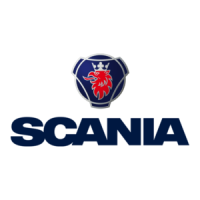
Do you have a question about the Scania DI9 and is the answer not in the manual?
| Engine Model | DI9 |
|---|---|
| Engine Type | Diesel |
| Cylinder arrangement | Inline |
| Number of cylinders | 5 |
| Displacement | 9.3 liters |
| Fuel System | Common Rail |
| Turbocharger | Yes |
| Intercooler | Yes |
| Cooling System | Liquid Cooled |
Critical safety warning about engine damage and personal injury if started during maintenance.
Safety measures for engine operation: inspection, refueling, hazardous gases, starting, and running.
Safe handling of fuels, oils, chemicals, and batteries, including storage and disposal guidelines.
Safety steps for maintenance: engine stop, hot surfaces, lifting, electrical, cooling, fuel, and before starting.
Explains the engine type designation code and the location of the engine serial number.
Overview of the DEC2 system, its functions, sensors, and control unit.
Illustrates sensor placement for DEC2 on DI9 engines.
Illustrates sensor placement for DEC2 on DC9 engines.
Explains LED indicators for normal operation and system responses to faults.
Procedures for reading fault codes, resetting functions, and identifying causes of engine issues.
Steps for initial engine startup, coolant checks, and glycol usage recommendations.
Includes daily checks, engine starting steps, and low-temperature starting advice.
Explains tachometer color zones and DEC2 control of engine speed.
Normal operating temperatures and DEC2's role in managing high coolant temperatures.
Details oil pressure ranges for hot engines at different speeds and actions for low pressure.
Step-by-step guide for safely stopping the engine, including DEC2 checks and power disconnection.
Comprehensive schedule for periodic maintenance tasks based on operating hours and time intervals.
Covers oil grade, analysis, change intervals, oil cleaner maintenance, and filter changes.
Procedures for checking coolant level, coolant condition, changing coolant, and cleaning the cooling system.
Instructions for vacuum indicator checks, coarse cleaner cleaning, filter element replacement, and safety cartridge.
Daily check of fuel level and periodic replacement of the fuel filter, including bleeding the system.
Guidelines for inspecting and testing fuel injectors, covering removal, fitting, and opening pressure.
Steps for checking battery electrolyte, charge state, and cleaning terminals and posts.
Procedures for checking the optional coolant monitor and temperature monitor/sensor.
Testing procedures for oil pressure sensor and monitor, including DEC2 specific monitor.
Guidance on changing the engine battery and inspecting the drive belt and tensioner.
Daily checks for fluid leaks and periodic adjustment of valve clearances.
Procedures for changing or cleaning the closed crankcase ventilation valve at specified intervals.
Measures to protect the engine from corrosion and rust during extended periods of inactivity.
Guidelines for using preservative coolant, fuel, and oil to protect the engine during storage.
Steps to prepare a stored engine for re-operation, including fluid checks and system priming.
Key performance and dimensional data for DC9 and DI9 engines.
Data for lubrication, cooling, fuel, and electrical systems, including pressures and volumes.
Data for fuel system parameters, system voltage, and alternator current.
Specifies properties like viscosity, density, sulphur content, and ignitability for diesel fuel.
Details classes of low-sulphur fuels and their impact on engine performance and catalytic converters.
Explains how fuel properties vary with temperature and precautions for cold climates.
